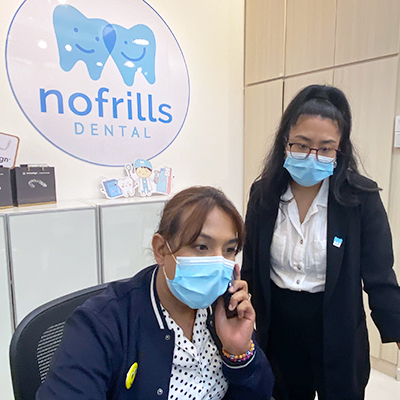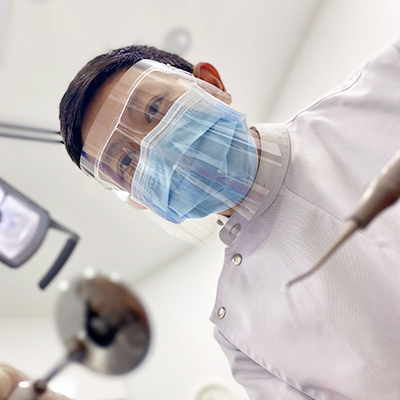Orthodontic Braces
Braces are a form of orthodontic treatment for the management and alignment of teeth. Braces corrects a wide variety of teeth straightening problems like Spacing, Crossbite, Open Bite, Overjet, Reverse Bite and Misplaced Tooth. Braces treatment can make your teeth look better, thus restoring your self-confidence and improve the overall quality of your life and social interactions.

Conventional Braces
Metal braces (1st generation) is the most common and popular form of treatment and consist of metal brackets stuck onto the front of teeth, rubber bands and an arch wire.
Pros:
– Cheap
– Choice of modules (coloured rubber bands) available
Cons:
– Most noticeable type of braces
– Less hygienic as it is difficult to clean in-between brackets
– Sharp ends of brackets often cause mouth ulcers
– Longer treatment time
Self-Ligating Braces
Self-ligating braces (2nd generation) use a ‘sliding door’ technique in which metal brackets are stuck onto the front of teeth, allowing the arch wire to slide back and forth without the need for rubber bands to hold it in place.
Pros:
– More hygienic than metal braces as less food gets trapped between brackets
– Requires fewer adjustments and visits to the dentists compared to conventional braces
– Shorter treatment time than 1st generation metal braces
– No staining problems
Cons:
– More expensive than 1st generation metal braces
– Technique sensitive
Lingual Braces
Lingual braces are very similar to conventional and self-ligating braces except that they are placed behind the teeth and less noticeable.
Pros:
– Less noticeable and not visible from outside
Cons:
– Difficult to clean
– More expensive
– May cause slight difficulties in speaking
– May hurt the tongue and be uncomfortable at first
– Regular adjustments take a longer time and are more difficult as compared to traditional braces
Clear Braces
Clear braces consist of ceramic or polycarbonate (plastic) brackets stuck onto the front of teeth, clear rubber bands and a Teflon coated or fibreglass arch wire. They can be either conventional or self-ligating.
Pros:
– Less noticeable than metal braces
Cons:
– More expensive than metal braces
– Ligature can stain easily without proper care
Benefits of Braces
Patients who put on braces can look forward to a nice smile, enhanced oral health, improved chewing abilities, better speech and increased self-esteem.
- Boost your confidence – Braces will increase your self-esteem by straightening your teeth and thus improving your appearance.
- Prevents decay and gum diseases – Braces decrease the likelihood of gum diseases and premature loss of teeth due to decay in crowded and overlapping teeth.
- Eliminate speech problems – Braces effectively corrects speech defects due to poor teeth alignment.
- Corrects poorly grown jaws – Braces assist in the development of your jawbone and helps correct problematic jaws in adulthood with the help of jaw surgery.
Treatment Process
During the first visit, our dentist will conduct a thorough orthodontic examination for you. He will also take an x-ray, a scan of your teeth, full face and profile photographs in order to recommend the best treatment plan for you.
On the next visit, your dentist will explain to you the relationship between soft tissue profile, jawbone and teeth as well as how these will affect your appearance.
Subsequent appointments involve insertion of the braces. After the braces are inserted, you will see our dentist every 4-8 weeks to have your braces adjusted.
FAQs on Braces
1. How long will the treatment take?
Braces treatment takes approximately 1-3 years to complete. The duration is dependent on the complexity of your condition, age as well as the expertise of our dentists. Patients can assist to shorten the treatment by being detailed about desired treatment goals, keeping a high standard of oral care, keeping appointments and starting young.
2. What is the best age to start putting on braces?
It is recommended to have your first visit for braces between the age of 6-12 years old as the most common reason for misaligned teeth is when there is overcrowding in the mouth. During the transition stage where the dentition is changing over to the permanent stage at this age, the bite may also be affected by poorly positioned teeth or uneven jaw bone growth. However, it is more common for patients to seek braces treatment at their early adolescent years when most of the permanent teeth have erupted. These patients can benefit from a faster and better treatment due to the favourable growth spurt that coincides with puberty.
3. Is it uncomfortable to put on braces?
Braces experience varies across patients and is highly dependent on your condition and the type of braces used. One should also expect teeth movement to cause mild to moderate discomfort for 2 to 3 days after each adjustment appointment. There may be an increase in ulcers but it can be managed using braces relief wax and topical steroid or analgesic ointments.
4. When will I be able to resume normal daily activities?
Most patients adapt to the presence of braces within the first month and will be able to eat, sing or play music instruments as per usual.
5. What should I expect after braces treatment?
Patients should put on their retainers full time (morning and night) during the first year after removing braces. You may feel odd and have speech difficulties after putting on retainers. These retainers can be removed for eating, brushing and so on. It is highly encouraged to wear the retainers religiously to allow the supporting bone and gums to mature, rewarding you with longer term stability. Patients who cannot adapt to removable retainers well should highlight this issue to the dentist early so that they can place a fixed retainer instead. A fixed retainer comprises a fine wire that is bonded on the back surfaces of the front teeth. Fixed retainers tend to trap food and make it harder to floss in between teeth. Regular preventive dental visits are compulsory for patients with fixed retainers.
6. What if my braces break or become loose?
Your braces are applied to your teeth with special “tooth glue”, which means that in rare occurrences brackets can dislodge themselves after your braces are applied. Please call our clinic if this happens and we will re-affix your brace.
7. Do I need to have my teeth extracted for braces treatment?
It depends on the crowdedness of your teeth. Sometimes, teeth can be aligned without the need for extractions. In some situations, extraction is needed to create space for aligning crooked teeth properly and achieving good overall treatment outcome.
8. I am already an adult. Is it too late for me to put on braces?
It is never too late to wear braces as long as your gums are in good condition.
Dental Services
Book an Appointment!

CHAS & Medisave Accredited Clinics
NoFrills Dental clinics in Singapore participate in Merdeka Generation, Pioneer Generation, CHAS Card and Medisave programs.

Flexible Payment Options Available
Contact us to know more about the versatile & flexible payment options offered at NoFrills Dental clinics.

Opening Hours
Monday - Friday: 10am to 7pm
Saturday: 10am to 5pm
Sunday & Public Holiday: Closed

Book an Appointment
NoFrills Dental offers a wide variety of high-quality dental services. Talk to us to book your next dental appointment with us.

